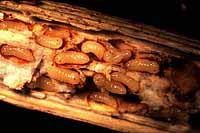Scientists find insects can alter plant chemistry to help them find mates

Gall wasp larvae feeding inside a stem of Silphium terebinthinacem (prairie dock) <br>Photos provided by John Tooker. <br> <br>
Each spring, amid the decaying rubble of dead prairie plants, emerging male gall wasps find mates by calling upon the chemistry prowess of their predecessors, entomologists scouring Central Illinois have discovered.
In the Proceedings of the National Academy of Sciences, they report that as adult gall wasps (Antistrophus rufus) feed in warm weather, they change the ratio of plant chemicals so that males emerging after the winter season can recognize when they are on the right stems at the right time. The study is being published in advance online the week of Nov. 18-22.
The finding is the first to suggest that insects can alter the chemical composition of plants for the purpose of mate location, said Lawrence M. Hanks, a professor at the University of Illinois at Urbana-Champaign.
The study also provides new insight on plant-insect ecology in widely diverse prairie habitats, which in Illinois have dwindled because of agriculture and urban growth to less than 1 percent of the acreage they once covered.
“Prairies hold unique plants and insects that are not thoroughly understood,” Hanks said. “This study is important because it shows that insects can influence plants for their own needs, using a substitute for sex pheromones.”
Specifically, the researchers found that male gall wasps respond to uneven chemical ratios in the plants. “As the insects feed, they change the plant chemistry, providing cues that help male wasps find females,” Hanks said. “This is interesting, because the females are inside the stems, so they are not producing pheromones. It’s a plant’s volatile chemicals that attract males.”
In essence, males smell their way to a mate. “They get chemical cues off the surface of the plant,” said co-author John F. Tooker, a doctoral student in entomology at Illinois. “It’s called a short-range volatile cue.”
“We don’t know how far away they can be and still smell it,” Tooker said, “but once they are on the right plant the males antennate the surface and begin looking for mates.” This rattling of antennae as they walk along the stem indicates they are on the right plant, “and this behavior helps them to find spots where female wasps will emerge.”
“The males find these sites and defend them,” he said. The males will head-butt one another, forcing some to leave. Others are driven off by wind or predators, such as spiders and beetles, requiring the wasps to find new stems amid the assorted plant debris.
Males, they found, only choose plant species that are the same as those from which they had emerged. The researchers monitored activity around two commonly found prairie plants: prairie dock (Silphium terebinthinaceum) and compass plant (Silphium laciniatum).
Winged flea-sized adult gall wasps live barely five days in the field, but they emerge continually over a 30-day period. They spend nine to 10 months as larvae living inconspicuously inside of the plants. Adult females emerge from dead stems of the plants, mate and lay eggs in live plant stems, forming galls that protect the larvae and provide nourishment. In the spring, males emerge first from the rotting stems.
Collaborator Wilfried A. Koenig, an organic chemist at the University of Hamburg in Germany, analyzed stem samples collected by Tooker and Hanks. The samples with galls had different enantiomeric ratios of monoterpenes than did the plants without galls.
It is the mix of two chemicals — alpha and beta pinenes — that males recognize. “Non-galled plants have a ratio of about 50-50, while galled plants have skewed ratios. If males find a stem with a 50-50 ratio,” Tooker said, “they will move on. If they find a stem with a 70-30 or a 100-0 ratio, they likely will stay and find females emerging from it.”
Tooker, who is seeking to understand how population control works for the wasps in natural prairie habitats, said the discovery was unexpected. “The botanists know all about the plants we are studying, but we donÕt know much about the insects in prairies,” he said. “Gall wasps are very small and easy to overlook. Unless you are in the fields at the right period of the right season you are never going to see them.”
Media Contact
More Information:
http://www.uiuc.edu/All latest news from the category: Life Sciences and Chemistry
Articles and reports from the Life Sciences and chemistry area deal with applied and basic research into modern biology, chemistry and human medicine.
Valuable information can be found on a range of life sciences fields including bacteriology, biochemistry, bionics, bioinformatics, biophysics, biotechnology, genetics, geobotany, human biology, marine biology, microbiology, molecular biology, cellular biology, zoology, bioinorganic chemistry, microchemistry and environmental chemistry.
Newest articles
Humans vs Machines—Who’s Better at Recognizing Speech?
Are humans or machines better at recognizing speech? A new study shows that in noisy conditions, current automatic speech recognition (ASR) systems achieve remarkable accuracy and sometimes even surpass human…

Not Lost in Translation: AI Increases Sign Language Recognition Accuracy
Additional data can help differentiate subtle gestures, hand positions, facial expressions The Complexity of Sign Languages Sign languages have been developed by nations around the world to fit the local…

Breaking the Ice: Glacier Melting Alters Arctic Fjord Ecosystems
The regions of the Arctic are particularly vulnerable to climate change. However, there is a lack of comprehensive scientific information about the environmental changes there. Researchers from the Helmholtz Center…



